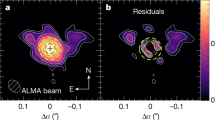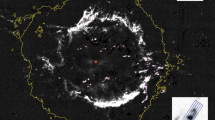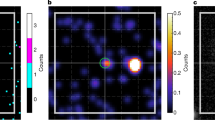Abstract
Molecular hydrogen (H2) is by far the most abundant material from which stars, protoplanetary disks and giant planets form, but it is difficult to detect directly. Infrared emission lines from H2 have recently been reported1 towards β Pictoris, a star harbouring a young planetary system2. This star is surrounded by a dusty ‘debris disk’ that is continuously replenished either by collisions between asteroidal objects3 or by evaporation of ices on Chiron-like objects4. A gaseous disk has also been inferred from absorption lines in the stellar spectrum5,6,7,8. Here we present the far-ultraviolet spectrum of β Pictoris, in which H2 absorption lines are not seen. This allows us to set a very low upper limit on the column density of H2: N(H2) ≤ 1018 cm-2. This non-detection is puzzling when compared to the quantity of H2 inferred from the infrared observations, but it does show that H2 is not in the disk on the direct line of sight. Carbon monoxide (CO) has been seen in absorption against the star8,9,10, yielding a ratio of CO/H2 > 6 × 10-4. As CO would be destroyed under ambient conditions in about 200 years (refs 9, 11), our result demonstrates that the CO in the disk arises from evaporation of planetesimals.
This is a preview of subscription content, access via your institution
Access options
Subscribe to this journal
Receive 51 print issues and online access
$199.00 per year
only $3.90 per issue
Buy this article
- Purchase on Springer Link
- Instant access to full article PDF
Prices may be subject to local taxes which are calculated during checkout


Similar content being viewed by others
References
Thi, W. F. et al. Substantial reservoirs of molecular hydrogen in the debris disks around young stars. Nature 409, 60–63 (2001).
Vidal-Madjar, A., Lecavelier des Etangs, A. & Ferlet, R. Beta Pictoris, a young planetary system? A review. Planet. Space Sci. 46, 629–648 (1998).
Backman, D. E. & Paresce, F. Main-sequence stars with circumstellar solid material—The Vega phenomenon. Protostars and Planets III (eds Levy, E. H. & Lunine, J. I.) 1253–1304 (Univ. Arizona Press, 1993).
Lecavelier des Etangs, A., Vidal-Madjar, A. & Ferlet, R. Dust distribution in disks supplied by small bodies: is the Beta Pictoris disk a gigantic multi-cometary tail? Astron. Astrophys. 307, 542–550 (1996).
Hobbs, L. M., Vidal-Madjar, A., Ferlet, R., Albert, C. E. & Gry, C. The gaseous component of the disk around Beta Pictoris. Astrophys. J. 293, L29–L33 (1985).
Vidal-Madjar, A., Ferlet, R., Hobbs, L. M., Gry, C. & Albert, C. E. The circumstellar gas cloud around Beta Pictoris. II. Astron. Astrophys. 167, 325–332 (1986).
Lagrange, A.-M. et al. The Beta Pictoris circumstellar disk. XXIV. Clues to the origin of the stable gas. Astron. Astrophys. 330, 1091–1108 (1998).
Roberge, A. et al. High-resolution Hubble Space Telescope STIS spectra of CI and CO in the Beta Pictoris circumstellar disk. Astrophys. J. 538, 904–910 (2000).
Vidal-Madjar, A. et al. HST-GHRS observations of Beta Pictoris: additional evidence for infalling comets. Astron. Astrophys. 290, 245–258 (1994).
Jolly, A. et al. HST - GHRS observations of CO and CI in the Beta Pictoris circumstellar disk. Astron. Astrophys. 329, 1028–1034 (1998).
van Dishoeck, E. F. & Black, J. H. The photodissociation and chemistry of interstellar CO. Astrophys. J. 334, 771–802 (1988).
Barrado y Navascués, D., Stauffer, J. R., Song, I. & Caillault, J.-P. The age of Beta Pictoris. Astrophys. J. 520, L123–L126 (1999).
Ferlet, R., Vidal-Madjar, A. & Hobbs, L. M. The Beta Pictoris circumstellar disk. V- Time variations of the CA II-K line. Astron. Astrophys. 185, 267–270 (1987).
Beust, H., Vidal-Madjar, A., Ferlet, R. & Lagrange-Henri, A. M. The Beta Pictoris circumstellar disk. X-Numerical simulations of infalling evaporating bodies. Astron. Astrophys. 236, 202–216 (1990).
Carruthers, G. R. Rocket observation of interstellar molecular hydrogen. Astrophys. J. 161, L81–L85 (1970).
Spitzer, L. et al. Spectrophotometric results from the Copernicus satellite. IV. Molecular hydrogen in interstellar space. Astrophys. J. 181, L116–L121 (1973).
Shull, J. M. & Beckwith, S. Interstellar molecular hydrogen. Annu. Rev. Astron. Astrophys. 20, 163–190 (1982).
Moos, H. W. et al. Overview of the Far Ultraviolet Spectroscopic Explorer Mission. Astrophys. J. 538, L1–L6 (2000).
Deleuil, M. et al. Is Beta Pictoris an active star? Astrophys. J. (in the press).
Roberge, A. et al. FUSE and HST STIS observations of hot and cold gas in the AB Aurigae system. Astrophys. J. 551, L97–L100 (2001).
Magnani, L., Onello, J. S., Adams, N. G., Hartmann, D. & Thaddeus, P. The variation of the CO to H2 conversion factor in two translucent clouds. Astrophys. J. 504, 290–299 (1998).
Kamp, I. & Bertoldi, F. CO in the circumstellar disks of Vega and Beta Pictoris. Astron. Astrophys. 353, 276–286 (2000).
Lecavelier des Etangs, A. Circumstellar disks and outer planet formation. Planets Outside the Solar System: Theory and Observations (eds Mariotti, J.-M. & Alloin, D.) 95–103 (Kluwer Academic, Dordrecht/Boston, 1999).
Liseau, R. & Artymowicz, P. High sensitivity search for molecular gas in the Beta Pic disk. On the low gas-to-dust mass ratio of the circumstellar disk around Beta Pictoris. Astron. Astrophys. 334, 935–942 (1998).
Acknowledgements
We thank Gopal-Krishna, G. Pineau des Forêts and S. Cabrit for discussions, and R. Kurucz for providing a model of the β Pic stellar atmosphere. The work at Johns Hopkins University was supported by NASA; the work at the Institut d’Astrophysique de Paris and at LAM was supported by CNES. The work reported here is based on data obtained by the NASA-CNES-CSA FUSE mission, operated by the Johns Hopkins University.
Author information
Authors and Affiliations
Corresponding author
Rights and permissions
About this article
Cite this article
Lecavelier des Etangs, A., Vidal-Madjar, A., Roberge, A. et al. Deficiency of molecular hydrogen in the disk of β Pictoris. Nature 412, 706–708 (2001). https://doi.org/10.1038/35089006
Received:
Accepted:
Issue Date:
DOI: https://doi.org/10.1038/35089006
This article is cited by
-
Closing gaps to our origins
Experimental Astronomy (2022)
-
Two families of exocomets in the β Pictoris system
Nature (2014)
-
Building galaxies, stars, planets and the ingredients for life between the stars. The science behind the European Ultraviolet-Visible Observatory
Astrophysics and Space Science (2014)
-
Comet-like mineralogy of olivine crystals in an extrasolar proto-Kuiper belt
Nature (2012)
-
Observational Diagnostics of Gas in Protoplanetary Disks
Earth, Moon, and Planets (2010)
Comments
By submitting a comment you agree to abide by our Terms and Community Guidelines. If you find something abusive or that does not comply with our terms or guidelines please flag it as inappropriate.



